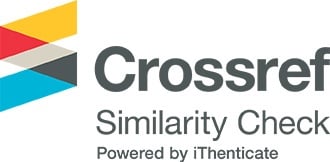Evaluation of in silico anticancer activity of some striazine derivatives as VEGFR2 inhibitors
Các tác giả
DOI: https://doi.org/10.59294/HIUJS.VOL.5.2023.545Từ khóa:
triazin, kháng ung thư, in silico, docking phân tử, VEGFR2Tóm tắt
The s-triazine derivatives have been shown to have diverse biological activities, especially anticancer activity. Fifty s-triazine derivatives were screened for anticancer activity through inhibition of VEGFR2 (vascular endothelial growth factor receptor-2) by molecular docking method using AutoDock Vina software. Compounds 20 and 40 showed the strongest interactions among all tested compounds with the binding affinity values of -10.8 and -10.5 Kcal/mol, respectively compared to reference drugs Gedatolisib (-9.1 Kcal/mol) and Paclitaxel (-7.8 Kcal/mol) at the active site of VEGFR2. These compounds established one carbon-hydrogen bond at amino acid HIS1026, specifically exhibiting better electrostatic and hydrophobic interactions than the reference drugs Gedatolisib and Paclitaxel. Moreover, compounds 20 and 40 also showed interactions with the VEGFR2 receptor that resemble the reference drug Gedatolisib at amino acids such as ARG1027, ASP1046, and HIS1026. Therefore, these compounds could be a potential lead molecule for anticancer activity.
Abstract
The s-triazine derivatives have been shown to have diverse biological activities, especially anticancer activity. Fifty s-triazine derivatives were screened for anticancer activity through inhibition of VEGFR2 (vascular endothelial growth factor receptor-2) by molecular docking method using AutoDock Vina software. Compounds 20 and 40 showed the strongest interactions among all tested compounds with the binding affinity values of -10.8 and -10.5 Kcal/mol, respectively compared to reference drugs Gedatolisib (-9.1 Kcal/mol) and Paclitaxel (-7.8 Kcal/mol) at the active site of VEGFR2. These compounds established one carbon-hydrogen bond at amino acid HIS1026, specifically exhibiting better electrostatic and hydrophobic interactions than the reference drugs Gedatolisib and Paclitaxel. Moreover, compounds 20 and 40 also showed interactions with the VEGFR2 receptor that resemble the reference drug Gedatolisib at amino acids such as ARG1027, ASP1046, and HIS1026. Therefore, these compounds could be a potential lead molecule for anticancer activity.
Tài liệu tham khảo
[1] P. Singla, V. Luxami, and K. Paul, “Triazine-benzimidazole hybrids: anticancer activity, DNA interaction and dihydrofolate reductase inhibitors,” Bioorg Med Chem., vol. 23(8), pp. 1691-1700, 2015.
DOI: https://doi.org/10.1016/j.bmc.2015.03.012[2] J. C. Weddell, S. Chen and P. I. Imoukhuede, “VEGFR1 promotes cell migration and proliferation through PLCγ and PI3K pathways,” NPJ Syst Biol Appl., vol. 4, p. 1, 2017.
DOI: https://doi.org/10.1038/s41540-017-0037-9[3] K. Holmes, O. L. Roberts, A. M. Thomas and M. J. Cross, “Vascular endothelial growth factor receptor-2: structure, function, intracellular signalling and therapeutic inhibition,” Cell Signal., vol. 19(10), pp. 2003-2012, 2007.
DOI: https://doi.org/10.1016/j.cellsig.2007.05.013[4] P. C. Em, L. T. Tuong Vi, L. H. Huong Ha, V. T. Bich Ngoc, B. V. Long, V. T. Thao, D. V. Duy, T. N. Ngoc Vi, N. L. Bao Khanh and N. T. Tuyen, “N,2,6-Trisubstituted 1H-benzimidazole derivatives as a new scaffold of antimicrobial and anticancer agents: Design, synthesis, in vitro evaluation, and in silico studies,” RSC Adv., vol. 13(1), pp. 399-420, 2023. DOI: 10.1039/d2ra06667j.
DOI: https://doi.org/10.1039/D2RA06667J[5] P. C. Em, L. T. Tuong Vi and N. T. Tuyen, “Design, synthesis, bio-evaluation, and in silico studies of some N-substituted 6-(chloro/nitro)-1H-benzimidazole derivatives as antimicrobial and anticancer agents,” RSC Adv., vol. 12(33), pp. 21621-21646, 2022. DOI: 10.1039/d2ra03491c.
DOI: https://doi.org/10.1039/D2RA03491C[6] P. C. Em, N. T. Tuyen, N. D. Hanh Nguyen, V. D. Duy and D. T. Hong Tuoi, “Synthesis of a series of novel 2-amino-5-substituted 1,3,4-oxadiazole and 1,3,4-thiadiazole derivatives as potential anticancer, antifungal and antibacterial agents”, Med. Chem., vol. 18, pp. 558-573, 2022. DOI: 10.2174/1573406417666210803170637.
DOI: https://doi.org/10.2174/1573406417666210803170637[7] P. C. Em, L. T. Tuong Vi, T. P. Long, T. N. Huong-Giang, N. L. Bao Khanh and N. T. Tuyen, “Design, synthesis, antimicrobial evaluations and in silico studies of novel pyrazol-5(4H)-one and 1H-pyrazol-5-ol derivatives,” Arab. J. Chem., vol. 15(3), p. 103682, 2022. DOI: 10.1016/j.arabjc.2021.103682.
DOI: https://doi.org/10.1016/j.arabjc.2021.103682[8] P. C. Em and N. T. Tuyen, “Design, microwave-assisted synthesis, antimicrobial and anticancer evaluation, and in silico studies of some 2-naphthamide derivatives as DHFR and VEGFR-2 Inhibitors,” ACS Omega., vol. 7(37), pp. 33614-33628, 2022. DOI: 10.1021/acsomega.2c05206.
DOI: https://doi.org/10.1021/acsomega.2c05206Tải xuống
Tải xuống: 149











